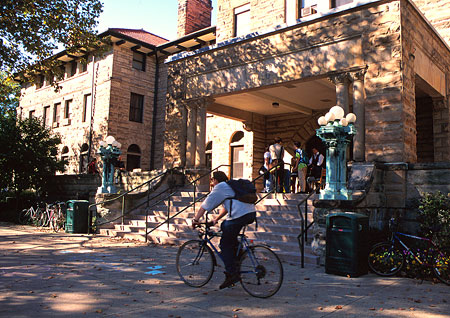Wilder Hall
 People who know that Thornton Wilder attended Oberlin College often believe that the College named the student union, Wilder Hall, for the famous playwright and novelist. The building is actually named for another man, Herbert Wilder, a Boston paper manufacturer, who anonymously provided funds for its construction.
People who know that Thornton Wilder attended Oberlin College often believe that the College named the student union, Wilder Hall, for the famous playwright and novelist. The building is actually named for another man, Herbert Wilder, a Boston paper manufacturer, who anonymously provided funds for its construction.
When the massive, sandstone structure was completed in 1911, it was called Men’s Building. Since the College’s founding, men had lived in boarding houses scattered throughout the town. The College had built residence halls for women, including Talcott and Baldwin, but not for men. The remedy was a Richardson Romanesque-style building, designed by architect Joseph Lyman Silsbee, intended to create a stronger bond and loyalty among the male students enrolled at Oberlin.
Though the building’s benefactor was not an alumnus of the College, he admired then-President Henry Churchill King’s aim to combine academic and musical excellence with religious principles. The College administration renamed the building for the donor in 1956.
Wilder Hall is the last of eight similar buildings to rise during Oberlin’s “Stone Age.” This transformation began in 1885, about 50 years after the College’s founding, and lasted 25 years. The building boom included Peters Hall, Talcott Hall, Baldwin Cottage, Severance Chemical Laboratory, Warner Gymnasium, Carnegie Library, and Rice Memorial Hall. All are thick, aggressively solid buildings made of heavy blocks of rough-textured buff Ohio sandstone. Six miles north of Oberlin is the huge quarry from which most of them came.
Located on West Lorain Street, Wilder Hall’s central location serves its current function as a student union. The original purpose of the building is evident, however, in its upper floors, where a variety of student organizations now uses a number of smaller rooms as offices and for meeting spaces.
Although the writer Thornton Wilder did not leave such a lasting mark on Oberlin history, he did begin his first successful dramatic work, The Angel That Troubled the Waters (1928) while at Oberlin. Wilder attended Oberlin for two years then transferred to Yale in 1917. He won the Pulitzer Prize for Drama for Our Town in 1938, and again in 1943 for The Skin of Our Teeth.
Sources: Geoffrey Blodgett’s Oberlin History (2006) and Oberlin Architecture College and Town: A Guide to its Social History (1985); Electronic Oberlin Group; the Thornton Wilder Society